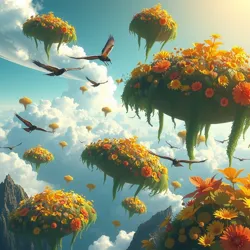Aurelia's Floating Biomes

Aurelia's Floating Biomes are a breathtaking phenomenon found on the gas giant Aurelia. These giant airborne ecosystems are sustained by the planet's helium-rich atmosphere, creating a unique habitat for a myriad of flying and floating creatures. The biomes are of significant interest to xenophotographers and xenobiologists, providing insight into how life can adapt to and thrive in extreme environments.
Description
Floating biomes on Aurelia are formed by massive clusters of buoyant flora that harness helium and other light gases to remain airborne. These clusters can span several kilometers and are often interconnected, creating vast networks of habitats suspended high above the planet's surface. The biomes are visually stunning, with vibrant hues stemming from the diverse plant life that thrives in the sunlight filtering through Aurelia's thick atmosphere.
The plant species found in these biomes have evolved specialized adaptations to capture and store helium, allowing them to float continuously. These plants serve as the foundation for a complex ecosystem, supporting various life forms, including unique avian species and other airborne organisms adapted to the low-gravity environment.
Xenophotography Significance
Aurelia's Floating Biomes are a popular subject among xenophotographers due to their ethereal beauty and the dynamic interplay of color and light. Capturing images of these biomes requires specialized equipment and techniques, as the constantly shifting atmospheric patterns and varying light conditions present significant challenges.
The biomes are often depicted in award-winning xenophotography, celebrated for their vibrant colors and the surreal sense of motion created by the floating flora and fauna. These images not only showcase the artistic potential of xenophotography but also contribute to the scientific understanding of alien ecosystems.
Related Phenomena
The study of Aurelia's Floating Biomes has led to the discovery of other fascinating airborne ecosystems across the galaxy. For instance, the Sky Gardens of Zyphronia are another example of a planet with floating biomes, though they differ significantly in structure and composition due to Zyphronia's unique atmospheric conditions.
Additionally, the Nebula of Harmony, a popular subject in xenophotography, offers insights into how dust and gas clouds in space can create environments that support unique forms of cosmic life.
See Also
- Titanium Peaks of Vexar
- Crimson Seas of Eldoria
- Sky Gardens of Zyphronia
References
- Xenophotography Society. (2023). The Wonders of Aurelia: Exploring the Floating Biomes. Galactic Press.
- Interstellar Ecology Journal. (2023). "Helium-Rich Ecosystems: Lessons from Aurelia's Biomes". Volume 42, Issue 7.
Embark on an interstellar journey through the lens of xenophotography and explore the universe's most captivating images.